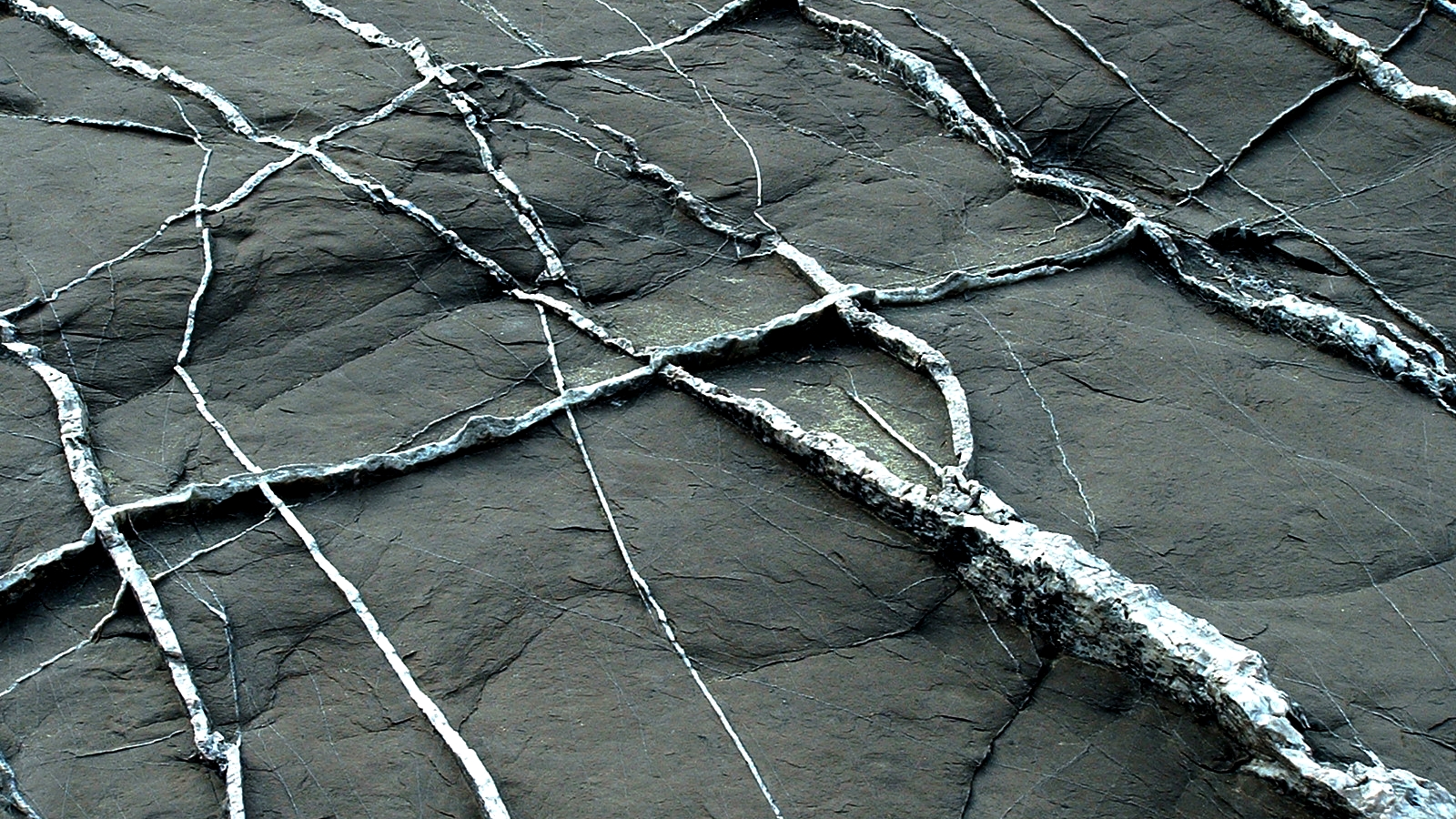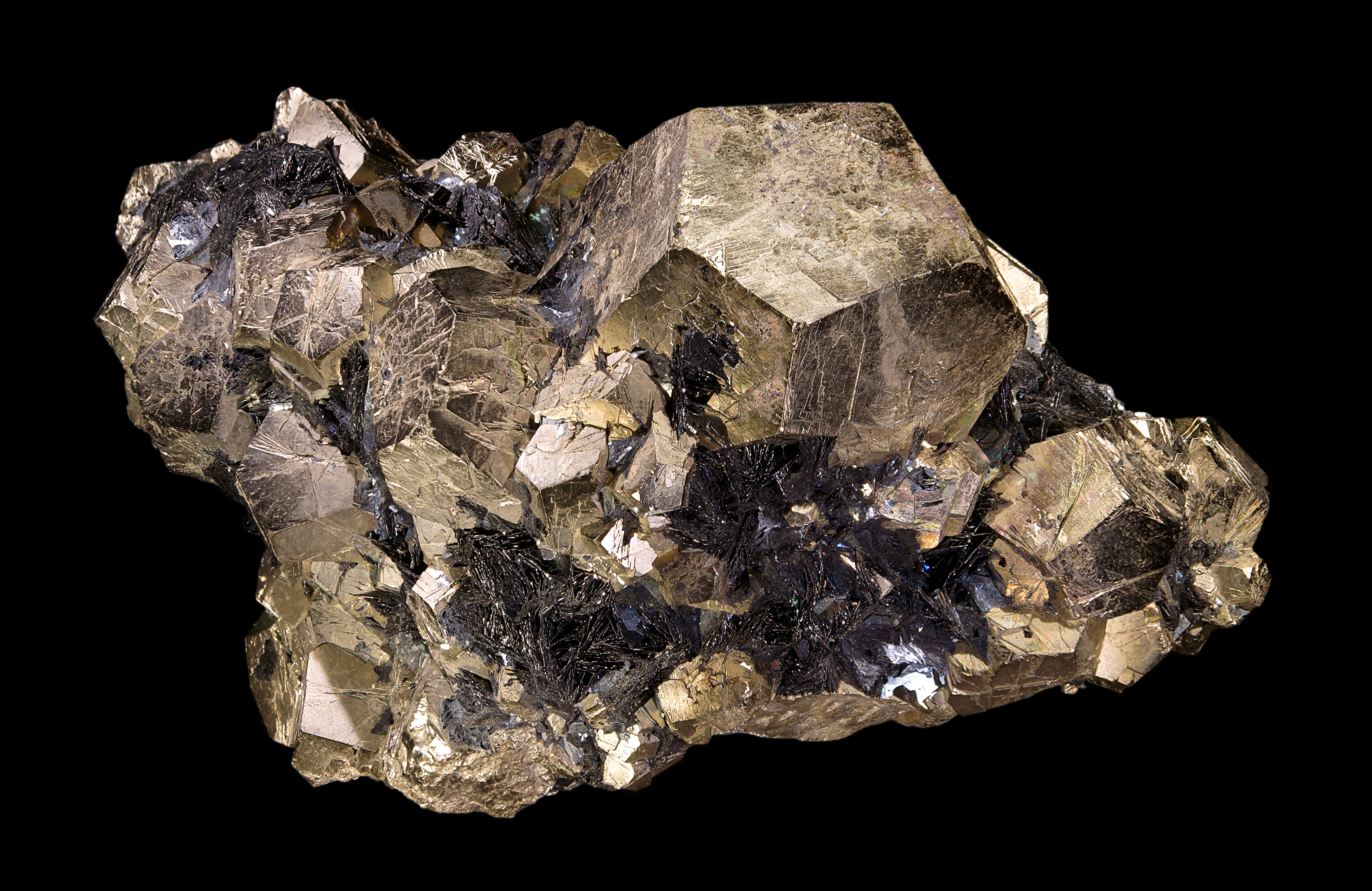|
Minnesotaite
Minnesotaite is an iron silicate mineral with formula: (Fe2+,Mg)3Si4O10(OH)2. It crystallizes in the triclinic crystal system and occurs as fine needles and platelets with other silicates. It is isostructural with the pyrophyllite-talc mineral group. Occurrence Minnesotaite was first described in 1944 for occurrences in the banded iron formations of northern Minnesota for which it was named. Type locality (geology), Co-type localities are in the Cuyuna Range, Cuyuna North Range, Crow Wing County, Minnesota, Crow Wing County and the Mesabi Range in St. Louis County, Minnesota, St. Louis County. It occurs associated with quartz, siderite, stilpnomelane, greenalite and magnetite. In addition to the low grade metamorphism, metamorphic banded iron formations it has also been reported as an alteration mineral associated with Sulfide mineral, sulfide bearing Vein (geology), veins. References {{Phyllosilicates Phyllosilicates Triclinic minerals Minerals in space group 2 ... [...More Info...] [...Related Items...] OR: [Wikipedia] [Google] [Baidu] |
Mesabi Range
The Mesabi Iron Range is a mining district and mountain range in northeastern Minnesota following an elongate trend containing large deposits of iron ore. It is the largest of four major iron ranges in the region collectively known as the Iron Range of Minnesota. First described in 1866, it is the chief iron ore mining district in the United States. The district is located largely in Itasca County, Minnesota, Itasca and St. Louis County, Minnesota, Saint Louis counties. It has been extensively worked since 1892, and has seen a transition from high-grade direct shipping ores through gravity concentrates to the current industry exclusively producing iron ore (taconite) pellets. Production has been dominantly controlled by vertically integrated steelmakers since 1901, and therefore is dictated largely by US ironmaking capacity and demand. Name The Mesabi Range was known to the local Ojibwe as ('Giant mountain'). Throughout the Mesabi Range, ''Mesaba'' and ''Missabe'' spelling va ... [...More Info...] [...Related Items...] OR: [Wikipedia] [Google] [Baidu] |
Silicate Mineral
Silicate minerals are rock-forming minerals made up of silicate groups. They are the largest and most important class of minerals and make up approximately 90 percent of Earth's crust. In mineralogy, the crystalline forms of silica (silicon dioxide, ) are usually considered to be Silicate mineral#Tectosilicates, tectosilicates, and they are classified as such in the Dana system (75.1). However, the Nickel-Strunz system classifies them as oxide minerals (4.DA). Silica is found in nature as the mineral quartz, and its polymorphism (materials science), polymorphs. On Earth, a wide variety of silicate minerals occur in an even wider range of combinations as a result of the processes that have been forming and re-working the crust for billions of years. These processes include partial melting, crystallization, fractionation, metamorphism, weathering, and diagenesis. Living organisms also contribute to this carbonate–silicate cycle, geologic cycle. For example, a type of plankton ... [...More Info...] [...Related Items...] OR: [Wikipedia] [Google] [Baidu] |
Vein (geology)
In geology, a vein is a distinct sheetlike body of crystallized minerals within a rock. Veins form when mineral constituents carried by an aqueous solution within the rock mass are deposited through precipitation. The hydraulic flow involved is usually due to hydrothermal circulation. Veins are classically thought of as being planar fractures in rocks, with the crystal growth occurring normal to the walls of the cavity, and the crystal protruding into open space. This certainly is the method for the formation of some veins. However, it is rare in geology for significant open space to remain open in large volumes of rock, especially several kilometers below the surface. Thus, there are two main mechanisms considered likely for the formation of veins: ''open-space filling'' and ''crack-seal growth''. Open space filling Open space filling is the hallmark of epithermal vein systems, such as a stockwork, in greisens or in certain skarn environments. For open space fillin ... [...More Info...] [...Related Items...] OR: [Wikipedia] [Google] [Baidu] |
Sulfide Mineral
The sulfide minerals are a class of minerals containing sulfide (S2−) or disulfide () as the major anion. Some sulfide minerals are economically important as metal ores. The sulfide class also includes the selenide mineral, selenides, the telluride mineral, tellurides, the arsenide mineral, arsenides, the antimonide mineral, antimonides, the bismuthinides, the sulfarsenides and the sulfosalts.http://www.minerals.net/mineral/sort-met.hod/group/sulfgrp.htm Minerals.net Dana Classification, SulfidesKlein, Cornelis and Cornelius S. Hurlbut, Jr., 1986, ''Manual of Mineralogy'', Wiley, 20th ed., pp 269-293 Sulfide minerals are inorganic compounds. Minerals Common or important examples include: * Acanthite *Chalcocite *Bornite *Galena *Sphalerite *Chalcopyrite *Pyrrhotite *Millerite *Pentlandite *Covellite *Cinnabar *Realgar *Orpiment *Stibnite *Pyrite *Marcasite *Molybdenite Sulfarsenides: *Cobaltite *Arsenopyrite *Gersdorffite Sulfosalts: *Pyrargyrite *Pro ... [...More Info...] [...Related Items...] OR: [Wikipedia] [Google] [Baidu] |
Metamorphism
Metamorphism is the transformation of existing Rock (geology), rock (the protolith) to rock with a different mineral composition or Texture (geology), texture. Metamorphism takes place at temperatures in excess of , and often also at elevated pressure or in the presence of chemically active fluids, but the rock remains mostly solid during the transformation. Metamorphism is distinct from weathering or diagenesis, which are changes that take place at or just beneath Earth's surface. Various forms of metamorphism exist, including Regional metamorphism, regional, Contact metamorphism, contact, Hydrothermal metamorphism, hydrothermal, Shock metamorphism, shock, and Dynamic metamorphism, dynamic metamorphism. These differ in the characteristic temperatures, pressures, and rate at which they take place and in the extent to which reactive fluids are involved. Metamorphism occurring at increasing pressure and temperature conditions is known as ''prograde metamorphism'', while decreasin ... [...More Info...] [...Related Items...] OR: [Wikipedia] [Google] [Baidu] |
Magnetite
Magnetite is a mineral and one of the main iron ores, with the chemical formula . It is one of the iron oxide, oxides of iron, and is ferrimagnetism, ferrimagnetic; it is attracted to a magnet and can be magnetization, magnetized to become a permanent magnet itself. With the exception of extremely rare native iron deposits, it is the most magnetic of all the naturally occurring minerals on Earth. Naturally magnetized pieces of magnetite, called lodestone, will attract small pieces of iron, which is how ancient peoples first discovered the property of magnetism. Magnetite is black or brownish-black with a metallic luster, has a Mohs scale of mineral hardness, Mohs hardness of 5–6 and leaves a black streak (mineralogy), streak. Small grains of magnetite are very common in igneous rocks, igneous and metamorphic rocks. The chemical IUPAC name is iron(II,III) oxide and the common chemical name is ''ferrous-ferric oxide''. Properties In addition to igneous rocks, magnetite als ... [...More Info...] [...Related Items...] OR: [Wikipedia] [Google] [Baidu] |
Greenalite
Greenalite is a mineral in the kaolinite- serpentine group with the chemical composition (Fe2+,Fe3+)2-3Si2O5(OH)4. It is a member of the serpentine group. Occurrence Greenalite was first described in 1903 for an occurrence in the Mesabi Range near Biwabik, St. Louis County, Minnesota and named for its green color. Greenalite occurs as a primary mineral in banded iron formations. Rocks which contain greenalite are usually bright green, pale green or pale brown. Greenalite occurs with quartz, stilpnomelane, siderite, chamosite, pyrite and minnesotaite. It is commonly oolitic. Effect on early life Greenalite, which is common in Archean rocks, formed rapidly in Archean seawater removing zinc, copper and vanadium in the process. This left the seawater rich in manganese, molybdenum, and cadmium Cadmium is a chemical element; it has chemical symbol, symbol Cd and atomic number 48. This soft, silvery-white metal is chemically similar to the two other stable metals in group 12 ... [...More Info...] [...Related Items...] OR: [Wikipedia] [Google] [Baidu] |
Stilpnomelane
Stilpnomelane is a phyllosilicate mineral. It has the chemical formula . Stilpnomelane occurs associated with banded iron formations. It is a metamorphic mineral associated with the blueschist and greenschist facies. It was first described in 1827 for an occurrence in Moravia in the Czech Republic. The name is derived from the Greek Greek may refer to: Anything of, from, or related to Greece, a country in Southern Europe: *Greeks, an ethnic group *Greek language, a branch of the Indo-European language family **Proto-Greek language, the assumed last common ancestor of all kno ... for shining, and for black. References Phyllosilicates Triclinic minerals Minerals in space group 2 {{silicate-mineral-stub ... [...More Info...] [...Related Items...] OR: [Wikipedia] [Google] [Baidu] |
Siderite
Siderite is a mineral composed of iron(II) carbonate (FeCO3). Its name comes from the Ancient Greek word (), meaning "iron". A valuable iron ore, it consists of 48% iron and lacks sulfur and phosphorus. Zinc, magnesium, and manganese commonly substitute for the iron, resulting in the siderite-smithsonite, siderite-magnesite, and siderite-rhodochrosite solid solution series. Siderite has Mohs hardness of 3.75 to 4.25, a specific gravity of 3.96, a white streak and a vitreous or pearly luster. Siderite is antiferromagnetic below its Néel temperature of that can assist in its identification. It crystallizes in the trigonal crystal system; crystals are rhombohedral in shape, typically with curved and striated faces. It also occurs in masses. Color ranges from yellow to dark brown or black, the latter being due to the presence of manganese. Siderite is commonly found in hydrothermal veins, and is associated with barite, fluorite, galena, and others. It is also a common ... [...More Info...] [...Related Items...] OR: [Wikipedia] [Google] [Baidu] |
Quartz
Quartz is a hard, crystalline mineral composed of silica (silicon dioxide). The Atom, atoms are linked in a continuous framework of SiO4 silicon–oxygen Tetrahedral molecular geometry, tetrahedra, with each oxygen being shared between two tetrahedra, giving an overall chemical formula of Silicon dioxide, SiO2. Quartz is, therefore, classified structurally as a Silicate mineral#Tectosilicates, framework silicate mineral and compositionally as an oxide mineral. Quartz is the second most abundant mineral in Earth's continental crust, behind feldspar. Quartz exists in two forms, the normal α-quartz and the high-temperature β-quartz, both of which are chiral. The transformation from α-quartz to β-quartz takes place abruptly at . Since the transformation is accompanied by a significant change in volume, it can easily induce microfracturing of ceramics or rocks passing through this temperature threshold. There are many different varieties of quartz, several of which are classifi ... [...More Info...] [...Related Items...] OR: [Wikipedia] [Google] [Baidu] |
Crow Wing County, Minnesota
Crow Wing County is a County (United States), county in the East Central part of the U.S. state of Minnesota. As of the 2020 United States census, 2020 census, the population was 66,123. Its county seat is Brainerd, Minnesota, Brainerd. The county was formed in 1857, and was organized in 1870. Crow Wing County is included in the Brainerd, MN Brainerd, Minnesota micropolitan area, Micropolitan Statistical Area. History This area was long occupied by the Ojibwe people, also known as Chippewa. In addition, numerous Dakota people lived in central and southern Minnesota before European settlement. European Americans established a trading post by 1837 in this area, on the east side of the Mississippi River opposite the mouth of the Crow Wing River. The post (named Crow Wing) soon became a center of trading with the region's Native Americans, with a general-supply store that served the area. By 1866, the village contained about 600 whites and Chippewa; it was a major population center ... [...More Info...] [...Related Items...] OR: [Wikipedia] [Google] [Baidu] |







